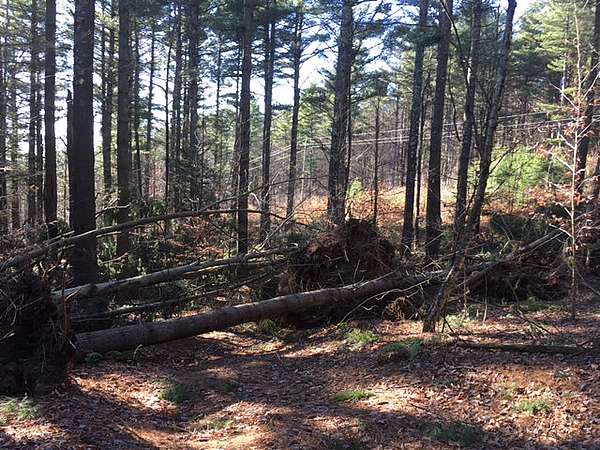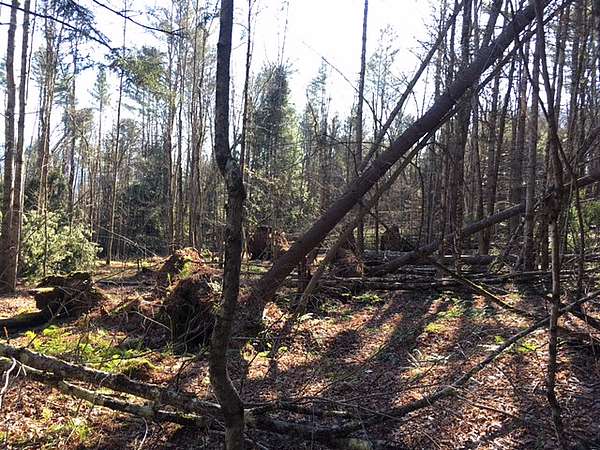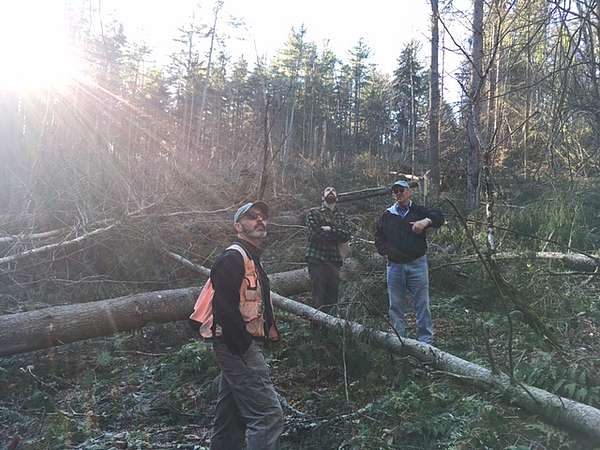Trail Impacts & Clean-up
The storm that knocked out power across town at the end of October also toppled quite a few trees on SLT’s conserved lands. Since the storm, we have been working with volunteers, landowners, the Lamoille County Forester, the Town of Stowe, and the Stowe Trails Partnership (formerly Stowe Mountain Bike Club) to understand the location, extent, and impact of the damage. Some areas were virtually unaffected, including Kirchner Woods, Mill Trail, Sunset Rock, Pinnacle Meadow, Adams Campand Sterling Forest. We’re grateful that trails on these properties are open and in great shape.
Wiessner Woods sustained minimal damage, with about 20 large trees down across trail network. Volunteers will be clearing those blowdowns on Monday, November 20th. Contact Kristen at kristen@stowelandtrust.org or 253-7221 if you’d like to lend a hand.
As many of us know, Nebraska Valley was hit quite hard. Alex’s Trail and DuMont Meadow are closed for the time being due to a significant cluster of blowdowns near the trailhead and scattered additional trees down across the rest of the path. Stay tuned for more information on a plan and schedule for clean-up.
What about Cady Hill?
Cady Hill Forest sustained the most severe damage with about 8 acres completely knocked over and widespread blowdowns across an additional approximately 55 acres. The trail network has been blocked and buried in many places. Combined with the safety hazards of overhanging limbs and broken branches, the Town of Stowe and Stowe Trails Partnership have closed all trails to the public and will likely keep them closed through the winter. Clean-up efforts are being planned in conjunction with consulting forester, Allan Thompson, of Northern Stewards LLC and Lamoille County Forester, Rick Dyer. Over the past two weeks, the foresters have been hard at work assessing the damage and options for planning a salvage harvest that would clear the trails and capture some of the economic value in the fallen trees. The salvage will likely be combined with some additional thinning and harvesting forestry work in wind-disturbed areas that will help meet the timber management and wildlife habitat goals for the property and make the clean-up project more financially viable.
The Town of Stowe and Stowe Trails Partnership, as the landowner and trails manager respectively, are taking the lead on planning and coordinating the clean-up effort at Cady Hill Forest. SLT is offering some support with planning and outreach. However, our primary role is to ensure that the long-term conservation values of the property are protected and that the terms of the easement area met - particularly the need to create a harvest plan for the project before clean-up work begins.
The foresters are working on putting together a plan and lining up loggers to start work as soon as possible. If conditions cooperate, it’s possible that the logging and trail clearing work could be completed this winter, which would allow Stowe Trails Partnership to begin trail repairs in the spring and reopen as much of the network as possible for the season. However, the full extent of damage to the trails won’t be known until they are cleared, so it’s possible that clean-up work could be a multi-year effort.
Ecological Impacts: A Silver Lining
The destructive impacts of the windstorm on our trail infrastructure are clear. However, from an ecological perspective, the long-term effects of all the blowdowns are different. Windthrow is a natural and ultimately regenerative part of forest ecosystems; forests respond to the increased sunlight in new openings with abundant growth. What looks like a big pile broken sticks at Year 1 will be transformed by Year 5 into a thicket of blackberries, raspberries and young trees. Openings in the forest’s canopy also create an ideal foraging environment for insectivorous birds, and young plants and trees provide browse for deer, moose, bear, rabbit, and many other species. Downed tree trunks and branches on the forest floor offers cover for wildlife, future soil, and carbon storage. Blowdowns also promote structural diversity and species diversity, an array of tree ages and species, which benefit the long-term health and resiliency of the forest.
In the case of most blowdowns, we are encouraging landowners to do what they need to do to clear their trails and areas around their homes, and then learn to embrace the positive ecological benefits of this disturbance. While it may be frustrating or counter-intuitive, these blowdowns are a natural part of forest growth and development, and provide some important benefit to wildlife and forest ecosystem health. That said, openings created by blowdowns can also be a great growing environment for non-native invasive plants like Japanese barberry, bush honeysuckle and glossy buckthorn. It's wise to keep an eye out for these invaders and take steps to control them when possible.
What You Can Do To Help
If you are looking for ways to help out with clean-up efforts or wondering what steps you should take to clean-up your own property, we encourage you to consider the following options:
- Lend a hand with clean-up efforts when SLT or Stowe Trails Partnership puts out a call for volunteers (like Monday, November 20 at Wiessner Woods!). Don’t tackle clearing trails on your own without checking in first. Some tip-ups and blowdowns are extremely dangerous and require the skill of a professional to remove safely.
- Make a donation to the Stowe Trails Partnership Trail Recovery effort. Visit www.stowemountainbike.com for more information or to donate.
- Call the Lamoille County Forester, Rick Dyer, if you need assistance or advice on how whether or how to address blowdowns on your own property. He can be reached at 802-888-5733 or rick.dyer@vermont.gov


